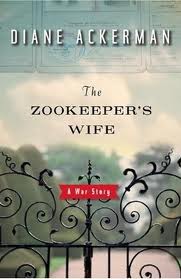The Zookeeper’s Wife by Diane Ackerman
Reviewed by Jennifer

Ratings Explanation
Violence: This is a war story, so there are many images of war. I was relieved, however, that the violence is portrayed quite matter-of-factly, no gore and not too many details. As German planes bomb Warsaw, the Zookeeper’s wife, Antonina, flees the city. The planes fly low and shoot at the people trying to escape. The scene of the dead and dying is etched into her memory. Soldiers shoot many of the more dangerous zoo animals before they can escape the enclosures. She describes a city under siege with bombs dropping, fear, hunger and death. The zoo is bombed, some of the remaining animals are killed. Nazi policy of death for any Pole who resisted or helped hide Jews. SS officers shoot remaining zoo animals for sport. Explanation of laws concerning Jews and the humiliations and beatings to which they were publicly subjected. A German soldier guarding the wall around the ghetto enjoys shooting Jewish children trying to escape. Jews from the ghetto, including 192 children from an orphanage and their priest, are loaded on trains and shipped to death camps (no description of the camps). Near the end of the war, the Jews left in the ghetto launch an uprising and fight the Nazis for sixty-three days – shooting, killing and burning.
Sexual Content: It is mentioned that women are raped, no descriptions.
Adult Themes: War. The Nazi’s “Jewish Solution”. The lost childhood of Rys, Antonina’s son, who basically grew up during the war. The unspeakable things that humans are capable of. How much are you willing to risk in order to help someone else?
Synopsis
Jan Zabinski and his wife Antonina are Polish zookeepers who shelter over 300 Jews in their home and zoo enclosures over the course of WWII. Brave and resourceful, Jan works with the Home Army to sabotage the Nazis and smuggle food and supplies into the Jewish ghetto as Antonina keeps their villa running while hiding several guests at a time both inside the house and outside in zoo buildings. The author, Diane Ackerman, also weaves in many other stories of those willing to risk all to save a few.
Ackerman paints a vivid physical picture of Poland with many descriptions of its natural beauties and resources. She also shares harrowing stories of survival and sacrifice that many Poles endured. While portraying the atrocities of war and the plight of the Jews, she retells a hopeful and uplifting story about all of the people who saw the need to help and acted upon it.
I loved this book and recommend it to all of you reading this post. Although it is not specifically written for youth, in my opinion it is appropriate for high school age readers. I asked myself all through the book, “Would I be willing to do that? Would I be willing to put my own family at risk in order to help others?” It is truly amazing to read about these real life heroes, but Jan and Antonina did not see themselves as heroic. As Jan said, “I only did my duty — if you can save somebody’s life, it’s your duty to try.”








